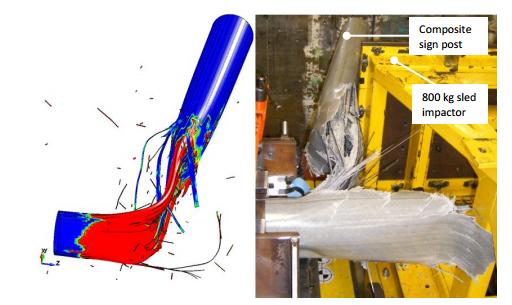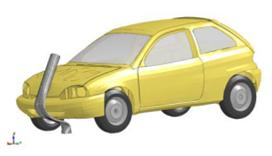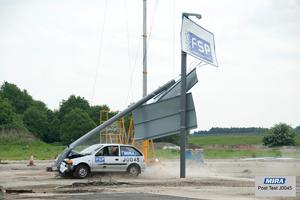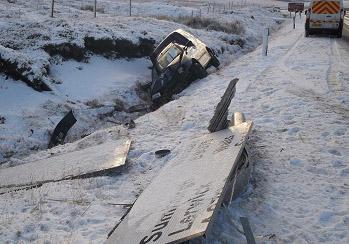Passively safe street furniture
Submitting Institution
University of NottinghamUnit of Assessment
General EngineeringSummary Impact Type
TechnologicalResearch Subject Area(s)
Engineering: Aerospace Engineering, Civil Engineering, Materials Engineering
Summary of the impact
Dr Richard Brooks and his team at the University of Nottingham have been
investigating the high strain rate behaviour of composite materials since
2003. This has led to the development of two products that are being
installed in streets in the UK and Ireland by East Midlands SME Frangible
Safety Posts Ltd. The direct benefits to the company have been: the
installation of 900 products in the UK and Ireland; saving of £17k capital
cost and 2 months in terms of time to market per product developed and;
raising of £1.8M investment to bring the products to market At least one
life has already been saved in the Shetland Islands as a direct
consequence of the product behaving in the way it was designed to.
Underpinning research
Dr Richard Brooks (Associate Professor, University of Nottingham, 2003 -
present) and Dr Kevin Brown (Research Associate, University of Nottingham,
2003-2013) have been investigating the impact behaviour of composites at
the University of Nottingham since 2003. This was developed to cover the
strain rate sensitivity [2.1] where the time dependent damage nature was
identified as having significant effects on the behaviour of the composite
material.
 Figure 1: Finite element model showing material behaviour of sign post
under crash conditions (left); Physical crash test of same material
performed at UoN labs (right). Note: excellent replication of model by
physical test.
Figure 1: Finite element model showing material behaviour of sign post
under crash conditions (left); Physical crash test of same material
performed at UoN labs (right). Note: excellent replication of model by
physical test.
This led to further work in 2006 to predictively model the impact
response of more complex thermoplastic composite sandwich structures [2.2]
where three point bending tests of composite sandwich structures
(fibre-reinforced thermoplastic skins and a polymer foam core made from
the same thermoplastic material) were performed and numerical schemes were
developed and implemented using finite element code (see Figure 1, left).
This work was validated on several prototype components including a novel
wind turbine blade and a safety critical rail component. The work was
developed further in 2008 to investigate the microscopic damage and relate
this to observed meso-scale (lab) and macro-scale (field) phenomena [2.3].
The research presented related to strain rate behaviour of thermoplastic
and thermoset composites mapped directly to the behaviour of structures
when subjected to impact such as when vehicles crash into composite
structures. This translated into a collaborative piece of work, funded
through the East Midlands Development Agency's Transport iNet scheme, to
develop the next generation of passively safe composite posts with
Frangible Safety Posts Ltd. This project (CompSafe) centred on using the
High Performance Computing (HPC) facilities at the University of
Nottingham to simulate the impact behaviour of different composite
material compositions to find the best solution using the MAT 162 model
(see below) in LS-DYNA-explicit Finite Element Analysis software.
MAT162 is an advanced elastic-damage model capable of simulating complex
multi-modal failure in both unidirectional and plain weave composites. It
requires a total of 34 materials properties and numerical modelling
parameters. Complexity is added from the nature of the hybrid structure
because each constituent has its own set of properties which require
definition. Over 100 input parameters were required to model the hybrid
structure. A calibration method developed by Brown [4] was used to obtain
appropriate values for these parameters.
The validated full scale crash model, as shown in Figure 2, provided the
platform to develop a design guide for passively safe hybrid composite
posts. The design guide aims to enable evaluation of the feasibility of
variations in the design of the composite post against the European
Standard EN12767 limits for ASI (Acceleration Severity Index) and THIV
(Theoretical Impact Velocity). The design parameters investigated
included: Number of carbon tows; Layup variation; Wall thickness
variation; Post diameter; Foundation type (granular sub base, sand,
concrete).
 Figure 2: Finite element simulation of whole car crashing against sign
post
Figure 2: Finite element simulation of whole car crashing against sign
post
Simulations of the validated crash model were made for each design
option. The ASI and THIV results were plotted for each design alteration.
This analysis indicated that the level of hybridisation within the
composite profile can have a significant effect on the impact performance
characteristic and that the designer can use this parameter when
considering products for alternative energy absorption categories.
As a result of working on CompSafe with the University of Nottingham,
Frangible Safety Posts Ltd has adopted the design guides to develop the
products described in Section 4. Structural properties of the resulting
products were also tested at the University of Nottingham (see Figure1,
right).
References to the research
References (Items marked with an asterisk indicate 3 most significant
outputs):
2.1 *Brown, K., Brooks, R. and Warrior N. A., 2010, The static and high
strain rate behaviour of a commingled E-glass/polypropylene woven fabric
composite, Composites Science and Technology, 70, 272-283. DOI:
10.1016/j.compscitech.2009.10.018
2.2 *Brooks, R., Brown, K.A., Warrior, N.A. and Kulandaivel, P.P., 2010,
Predictive modelling of the impact response of thermoplastic composite
sandwich structures, Journal of Sandwich structures and materials,
12:449 (originally published online 10 June 2009) DOI:
10.1177/1099636209104537
2.3 *Lidgett, M., Brooks, R., Warrior, N. and Brown, K.A., 2011, Virtual
modelling of microscopic damage in polymer composite materials at high
rates of strain, Plastics, Rubber and Composites, 40(6/7),
324-332. DOI: 10.1179/1743289810Y.0000000007
2.4 Brown, K.A., 2007, Finite element modelling of the static and dynamic
impact behaviour of thermoplastic composite sandwich structures, PhD
thesis, University of Nottingham, copy available on request
Grants:
Brooks R, Competitive Design of Passively Safe Composite Profiles for
Transport Safety (CompSafe), Transport iNet, http://www.transport-inet.org.uk/portfolio/epl-composite-solutions-and-
frangible-sign-posts-ltd/
Details of the impact
The University of Nottingham's research into the high strain-rate
behaviour of composite metals has resulted in significant industry
engagement and adoption, economic benefits and — as already demonstrated
in a real-life setting — major improvements in safety. This has resulted
in faster and cheaper development of the 168mm and 219mm diameter sized
street posts [4.1], which were formally launched in June 2010. As of March
2013, 900 are installed in the UK and Ireland [4.2]
The University of Nottingham, through the involvement of Dr Brooks and Dr
Brown, has played a central role in the development of these two products,
providing numerical simulations of high strain rate behaviour that have
resulted in the specific material composition of the street posts. Sales
of these two products account for 60% of the company's revenues and 50% of
the profits. 6 jobs have been created to produce, sell and install these
products [4.2].
Key outcomes resulting from the underpinning research include [4.2]:
- Use of the pendulum testing methodology (the term used to describe the
virtual testing methodology, the development of which is described in
Section 2) to replace full vehicle crash testing. Pendulum testing
alone: estimated cost savings of up to 70% per result. Elapsed time
estimated savings of up to 83% per result.
- Use of the design guide to replace full vehicle testing within
iterative product development. Use of the design guide during product
development: estimated cost savings of up to 90% per result. Elapsed
time estimated savings of up to 93% per result.
- Use of the design guide and computer simulation to replace full
vehicle testing for product accreditation. Use of the design guide &
simulation for full product accreditation: estimated cost savings of up
to 72% per result. Elapsed time estimated savings of up to 62% per
result.
Savings in bringing the products to market as a result of the modelling
work done by the University of Nottingham amount to approximately £17k per
product through minimising the number of physical crash tests that had to
be performed and 2 months were saved in terms of the time to market. In
the future this could increase to £99.6k and 4 months saving if the
modelling fully replaces vehicular crash testing [4.2].
 Figure 3: Picture of the real crash test simulated in Figure 2
Figure 3: Picture of the real crash test simulated in Figure 2
Furthermore, the research provided valuable data that was used to secure
an investment of £1.8m from Ahlstrom Capital (one of Finland's biggest
private equity investors, portfolio turnover exceeding €1Bn) to bring the
product to market [4.3].
In addition to the economic impacts, there has been at least one clear
example of the improvements in safety offered by these products: A vehicle
struck one post of a two post Frangible Safety Post installation and the
driver walked away unscathed. It is likely that, should the vehicle have
struck a traditional steel post installation, the driver would have
suffered significant injuries [4.4].
FSP had their posts installed throughout the Shetland Islands in 2010 and
2011 [4.5] and commenting on this accident Neil Hutcheson, Roads Engineer
at Shetland Island Council said:
"We recently renewed a large number of advanced direction signs and
took the opportunity to replace the existing steel posts with the
passive safety equivalent supplied by FSP. This incident has shown that
to be the correct decision. I have no doubt that the vehicles occupant
would have been seriously injured if we had retained the steel posts. We
consider that these passive safety posts can play a significant part in
reducing casualty rates and making Shetland's roads safer" [4.4].
On the 4th December 2012 in icy conditions there was an accident on the
A970 on the Shetland Islands. A vehicle struck one post of a two post
Frangible Safety Post installation and the driver walked away unscathed.
It is likely that should the vehicle have struck a traditional steel post
installation the driver would have suffered significant injuries. The
Frangible Safety Post that was struck performed and reacted exactly as
intended through our patented design. [4.4]
 Figure 4: Damaged post and car as result of Shetland Islands incident
Figure 4: Damaged post and car as result of Shetland Islands incident
Sources to corroborate the impact
4.1 http://www.fsp-ltd.com/docs/june2010/fsp_launch_new_products_10.06.10.pdf
4.2 Dr Nick Weatherby, Technical Director, EPL Composite Solutions Ltd
4.3 Ahlstrom annual report (page 21) available at
http://www.ahlstromcapital.com/PDF/ACOY_Annual%20Report%202012.pdf
4.4 http://www.therichworks.co.uk/more_info.asp?current_id=2155
— an independent, non-competitive site that provides everything you need
to know about construction and highways in the UK. Endorsed by the
Highways Agency and leading contractors such as URS.
4.5 Dr Gerry Boyce, Director, Frangible Safety Posts Ltd.